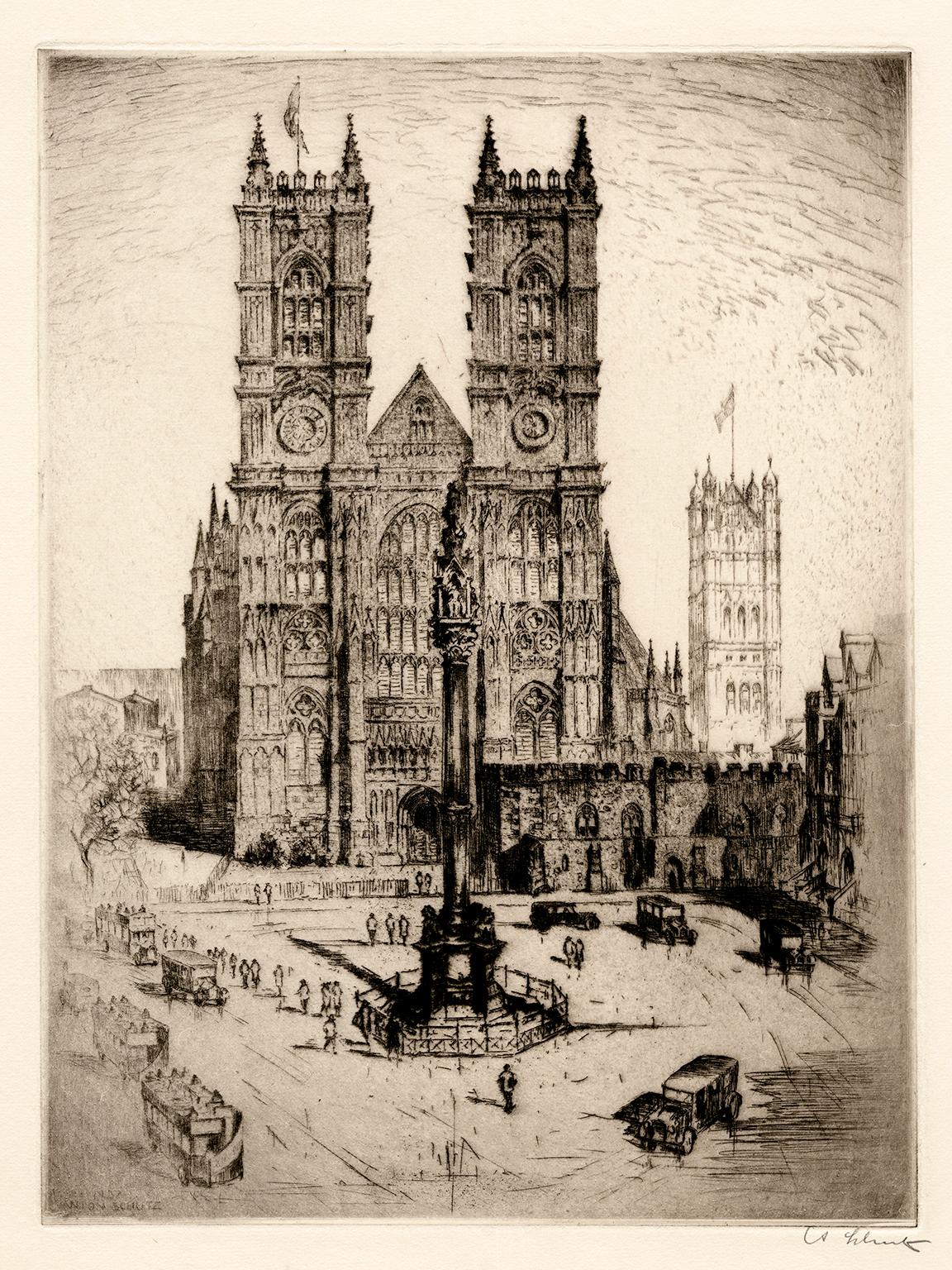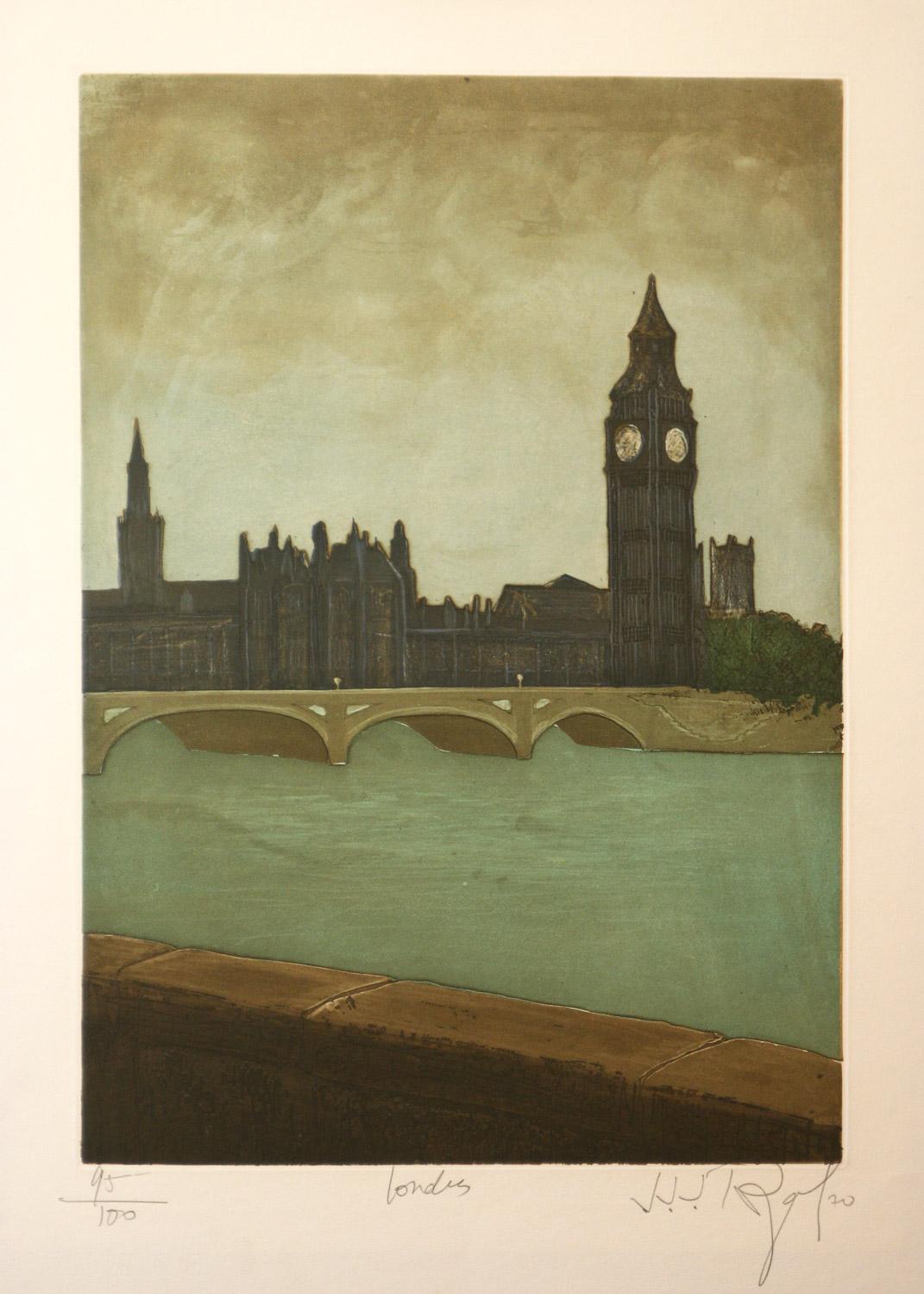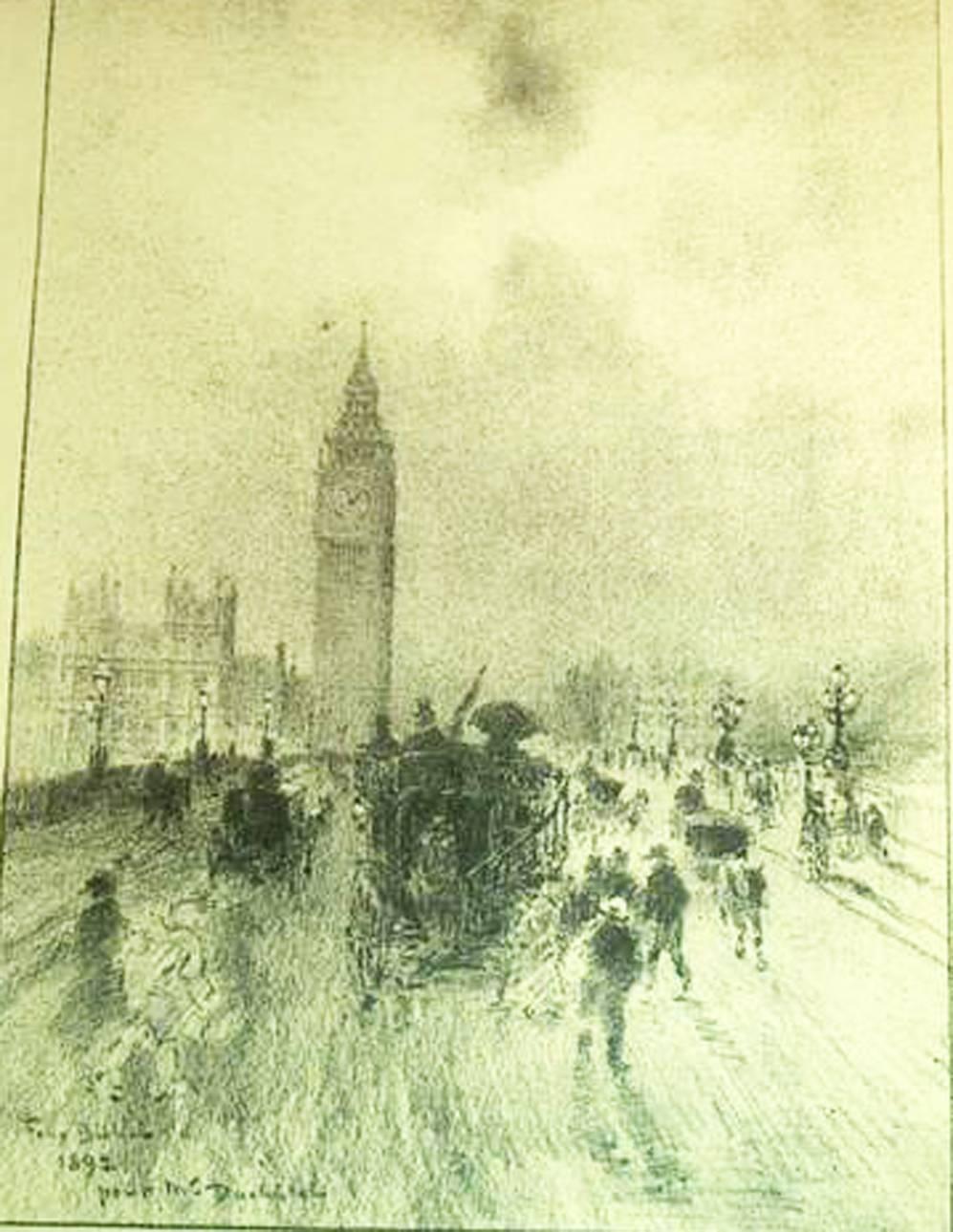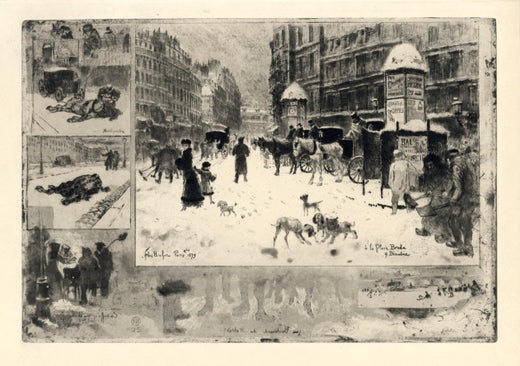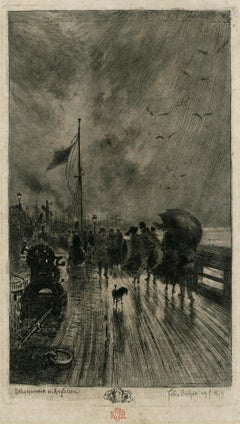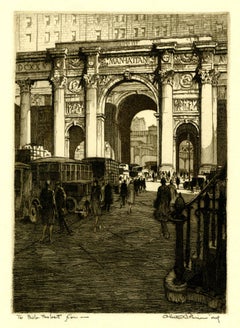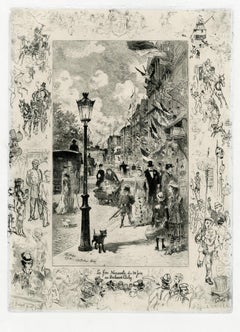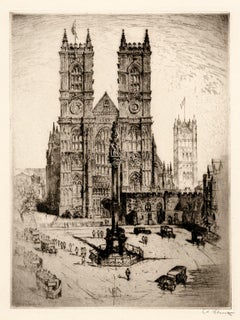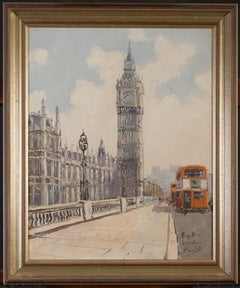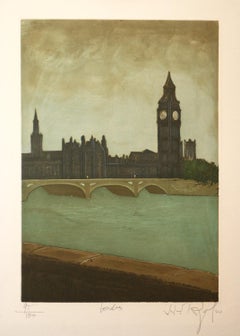Articoli simili a Westminster Palace
Vuoi altre immagini o video?
Richiedi altre immagini o video al venditore
1 di 12
Félix Hilaire BuhotWestminster Palace1884
1884
3070,02 €
Spedizione
Recupero del preventivo…La promessa 1stDibs:
Garanzia di autenticità,
Garanzia di rimborso,
Annullamento entro 24 ore
Informazioni sull’articolo
Westminster Palace
Etching, Drypoint, Aquatint, roulette and salt ground lift
1884
Depicts the Houses of Parliament, Big Ben Clock and Tower and the River Thames in the foreground.
Signed with the artist’s large Red Owl stamp, Lugt 977
Printed on thin wove japan, (almost parchment like) with full margins
A rich cleaned whipped impression showing burr in the central compositions, the remarques printing with atmospheric selective inking
This example is one of three depictions of Westminster that the artist created. One similar format etching and a vertical lithograph.
Condition: Excellent
Image/Plate Size: 11 7/16 x 15 5/8 inches
Sheet size: 14 1/4 x 18 3/4 inches
Reference: Bourcard/Goodfriend 155 vi/VIII, before the words "In pro..."
A rare proof
Impressions of this image are the collections of the following institutions:
Art Institute of Chicago
Minneapolis Institute of Art
Metropolitan Museum of Art
Van Gogh Museum
National Gallery of Art, Washington
High Museum, Atlanta
British Museum
Smart Museum, Chicago (canceled plate impression)
Achenbach Foundation of the Graphic Arts, FAMSF
Considered one of the artist's finest images.
Félix-Hilaire Buhot
French, 1847 - 1898
Among the most original prints made in France during the last quarter of the nineteenth century are those by Félix Buhot. Born in 1847 in the small Normandy town of Valognes, in northern France, Buhot moved to Paris in 1865, where a year later he enrolled in the École des Beaux-Arts, studying painting and drawing under various artists. Buhot first learned to etch in about 1873, producing his first etching later that year and quickly establishing himself as a successful printmaker. The young artist made his living by decorating fans and illustrating lithographic sheet music. Buhot lived and worked most of his life in Paris, with frequent visits back to northern France and extended trips to England where he met his wife, Henrietta Johnston, whom he married in 1881. By 1892 Buhot had ceased making prints, and in 1898, after suffering prolonged bouts of deep depression, he died at the age of fifty-one.
Along with Edgar Degas and Camille Pissarro, Félix Buhot numbers among the most experimental printmakers of his day. In exploring the unique aspects of etching, he developed an approach to printmaking that was very painterly; in fact he called his prints "paintings on copper." A true printmaker's printmaker, Buhot delighted in all the technical variables and regularly combined multiple processes to produce a single print: he achieved even greater tonal variation by employing the more traditional techniques of etching, drypoint, and aquatint along with several less familiar methods. Unlike many contemporary printmakers who disliked photography, Buhot heartily embraced the medium and used it as a creative aid. He also used different inks and papers for varied effects. His most original contribution to the history of printmaking is a device he termed marges symphoniques (symphonic margins): by amplifying the main subject, such illustrations became an integral part of the print.
In his many prints of city views and seascapes, Buhot was intent on creating a specific atmosphere, especially the effects of weather such as rain, snow, mist, and fog. He turned to his immediate neighborhood in and around the boulevard de Clichy in Montmartre, Paris, for inspiration for his prints of everyday city life. Buhot delighted in portraying the varied street life of the vibrant capital city not only in different seasons (Winter in Paris, 1879) but also in moments of public display, from a festive holiday celebration (National Holiday on the Boulevard de Clichy, 1878) to a somber death observance (Funeral Procession on the Boulevard de Clichy, 1887). His city views also include London scenes (Westminster Palace and Westminster Bridge, both of 1884). And Buhot's love for the sea is evidenced in the many prints exploring its ever-changing atmospheric conditions and moods. Buhot's boat trips to England inspired two of his most characteristic prints, A Pier in England and Landing in England, both from 1879.
With his experimental printmaking techniques, Buhot became one of the best-known, admired, and collected printmakers of his day. He achieved success for his prints at the annual Salons between 1875 and 1886, and a number of his works were published in leading periodicals and books. He also found critical acclaim and support for his prints in the United States, especially after his first one-man exhibition organized by the New York print dealer Frederick Keppel in 1888.
Courtesy: National Gallery of Art, Washington, D. C.
- Creatore:Félix Hilaire Buhot (1847 - 1898, Francese)
- Anno di creazione:1884
- Dimensioni:Altezza: 29,11 cm (11,46 in)Larghezza: 39,71 cm (15,63 in)
- Tecnica:
- Movimento e stile:
- Periodo:
- Condizioni:
- Località della galleria:Fairlawn, OH
- Numero di riferimento:Venditore: FA111551stDibs: LU14014196842
Félix Hilaire Buhot
Le stampe di Buhot sono state realizzate in un momento di rinnovato interesse per la stampa originale (soprattutto l'acquaforte), che stava rapidamente diventando più popolare dell'incisione riproduttiva. Le sue incisioni furono elogiate già nel 1874 dal critico Philippe Burty, che ammirava le belles épreuves (belle prove) dell'artista, termine con cui Burty indicava rare impressioni superbamente inchiostrate e stampate dall'artista stesso. Negli anni '80 del XIX secolo Buhot era diventato uno dei più noti e collezionati stampatori del suo tempo. La fama di Buhot si estese ben oltre il suo paese e anche negli Stati Uniti ricevette il plauso della critica e un forte sostegno per le sue stampe. Nel 1888 il commerciante di stampe di New York Frederick Keppel (1845-1912) organizzò per Buhot la sua prima mostra personale, che ebbe un discreto successo. Oltre a Keppel, Buhot divenne amico di due importanti collezionisti americani della fine del XIX secolo che accumularono un gran numero di stampe dell'artista: Samuel P. Avery (1822-1904) di New York raccolse oltre 300 stampe e George A. Lucas (1824-1909) di Baltimora ne possedeva circa 200. A partire dal 1911, un'altra grande collezione fu formata da Albert H. Wiggin (1868-1951) di Boston, che acquistò oltre 150 impressioni. Oggi queste collezioni si trovano rispettivamente alla New York Public Library, al Baltimore Museum of Art e alla Boston Public Library.
Informazioni sul venditore
5,0
Venditore riconosciuto
Questi venditori prestigiosi sono leader del settore e rappresentano il massimo in termini di qualità e design.
Venditore Oro
Venditori Premium con valutazione 4,3+ e tempi di risposta entro 24 ore
Fondazione nel 1978
Venditore 1stDibs dal 2013
798 vendite su 1stDibs
Tempo di risposta standard: <1 ora
Associazioni
International Fine Print Dealers Association
- SpedizioneRecupero del preventivo…Spedizione da: Akron, OH
- Politica di reso
Alcune parti di questa pagina sono state tradotte automaticamente. 1stDibs non può garantire che le traduzioni siano corrette. L’inglese è la lingua predefinita del sito.
Garanzia di autenticità
Nell’improbabile caso in cui si verifichi un problema con l’autenticità di un articolo, contattaci entro un anno per ottenere un rimborso completo. DettagliGaranzia di rimborso
Se il tuo articolo non corrisponde alla descrizione, è danneggiato durante il trasporto o non arriva, contattaci entro 7 giorni per un rimborso completo. DettagliAnnullamento entro 24 ore
Hai un periodo di tolleranza di 24 ore per annullare il tuo acquisto, senza necessità di fornire spiegazioni.Venditori professionali selezionati
I nostri venditori di livello internazionale devono aderire a rigorosi standard di servizio e qualità, garantendo l’integrità delle inserzioni.Garanzia miglior prezzo
Se scopri che un venditore ha pubblicato altrove lo stesso articolo a un prezzo più basso, applicheremo lo stesso prezzo.Consegna globale affidabile
La nostra rete di vettori leader del settore offre opzioni di spedizione specializzate in tutto il mondo, inclusa la consegna personalizzata.Altro da questo venditore
Mostra tuttoUn Debarquement en Angleterre (Uno sbarco in Inghilterra)
Di Félix Hilaire Buhot
Un Debarquement en Angleterre
(Uno sbarco in Inghilterra)
acquaforte, puntasecca, acquatinta, roulette e terra a spirito, 1879
Firmato con il timbro del gufo rosso dell'artista, Lugt...
Categoria
Anni 1870, Impressionismo, Stampe (paesaggio)
Materiali
Puntasecca
L'edificio comunale di Manhattan
Di Chester B. Price
Firmato a matita e annotato "imp" in basso a destra; dedicato in basso a sinistra: "A Bob Nisbet da...".
Nota: Progettato da William M. Kendall dello studio McKim, Mead e White, q...
Categoria
Anni 1910, Stampe (paesaggio)
Materiali
Puntasecca
Fleet Street, Londra
Di Luigi Kasimir
Fleet Street, Londra
Acquaforte e acquatinta a fondo morbido, 1936 ca.
Firmato a matita dall'artista (vedi foto)
Condizioni: Condizioni molto buone con nastro di carta marrone lungo ...
Categoria
Anni 1930, Stampe (paesaggio)
Materiali
Acquaforte, Xilografia
La Festa Nazionale del Boulevard Clichy
Di Félix Hilaire Buhot
La Festa Nazionale del Boulevard Clichy
Acquaforte, puntasecca e acquatinta, 1878
Firmato in basso a sinistra nel piatto (vedi foto)
Chine collee stampata, montata su carta bianca
Il...
Categoria
Anni 1870, Scuola francese, Stampe figurative
Materiali
Acquaforte
Palazzo, Firenze
Di Rudy O. Pozzatti
Palazzo, Firenze
Acquaforte, incisione, acquatinta, fondo morbido e fondo sollevato, stampata a colori da tre lastre di rame. 1954
Firmato a matita in basso a destra (vedi foto)
Ediz...
Categoria
Anni 1950, American Modern, Stampe (paesaggio)
Materiali
Acquatinta
Il Duomo di Firenze
Di Donald Shaw MacLaughlan
Il Duomo di Firenze
Acquerello, 1914
Firmato e datato in basso al centro (vedi foto)
Il Duomo di Firenze, formalmente Cattedrale di Santa Maria del Fiore, è la cattedrale di Firenze...
Categoria
Anni 1910, American Modern, Disegni e acquarelli (paesaggio)
Materiali
Acquarello
Ti potrebbe interessare anche
Palazzo di Westminster
Di Félix Hilaire Buhot
Felix Buhot (1847-1898), Palazzo di Westminster, acquaforte, puntasecca, roulette, 1884, firmato a matita e ampiamente annotato. Bourcard/Goodfriend 155, terzo stato di Bourcard (su ...
Categoria
Anni 1880, Impressionismo, Stampe (paesaggio)
Materiali
Puntasecca, Acquaforte
Abbazia di Westminster" - Chiesa reale di Londra
Di Anton Schutz
Anton Schutz, 'Abbazia di Westminster', acquaforte, edizione non dichiarata, 1927. Firmato a matita. Firmato e datato nella lastra, in basso a sinistra. Impressione superba, riccamen...
Categoria
Anni 1920, Realismo americano, Stampe (paesaggio)
Materiali
Acquaforte
Ben, Westminster, Londra. 1970's
Morris o Morius, un pittore sconosciuto con un'attitudine alla pennellata stravagante e cavalleresca, chiaramente un artista molto esperto e sicuro di sé, che rimane anonimo per i n...
Categoria
Anni 1970, Dipinti (paesaggio)
Materiali
Olio, Tavola
Londra, Inghilterra Incisione originale firmata all'acquatinta da J.J. Regale
Londra, Inghilterra è un'acquatinta originale firmata in edizione limitata. incisione dell'artista francese J.J. Regal stampato su carta BFK Rives. Si tratta di un design molto ...
Categoria
XX secolo, Espressionista, Stampe (paesaggio)
Materiali
Acquaforte
Acquerello della metà del XX secolo - Il Parlamento dalla Corte di Whitehall
Un'incantevole vista delle Houses of Parliament da Whitehall Court al tramonto. Inscritto con posizione in basso a destra. Illegittimamente iscritto con firma. Presentato in una corn...
Categoria
XX secolo, Disegni e acquarelli (paesaggio)
Materiali
Acquarello
214 € Prezzo promozionale
20% in meno
LA TORRE DELL'OROLOGIO VICTORIA, LONDRA
Di Félix Hilaire Buhot
Buhot, Felix. LA TORRE DELL'OROLOGIO VICTORIA, LONDRA. BG 184. Litografia, 1892. 9 x 6 3/8 pollici; 230 x 163 mm., immagine; foglio 15 x 11 pollici; 381 x 279 mm. Firmato nella pietr...
Categoria
Anni 1890, Stampe (paesaggio)
Materiali
Litografia
